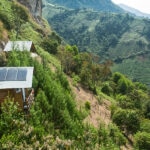Climate technologies are innovative solutions that aim to combat climate change by slashing emissions and capturing carbon from the atmosphere. According to experts, this industry could generate €600 billion in annual revenue by 2030.

Climate technologies are innovative solutions that aim to combat climate change by slashing emissions and capturing carbon from the atmosphere. According to experts, this industry could generate €600 billion in annual revenue by 2030.
These climate technologies fall within the broader concept of what are known as cleantech, which is short for clean technologies: those that aim to overcome environmental problems in general. Unlike climatech, cleantech is not just used to fight climate change but also to address the biodiversity crisis, waste treatment, and plastic pollution. A prime example of cleantech would be solar panels, which in countries like Argentina—thanks to BBVA’s Volunteering Plan and the Fundación Sumando Energías—are being used to harness solar energy to heat water in the homes of vulnerable families while also reducing greenhouse gas (GHG) emissions and combating climate change.
“Cleantech means innovative, non-polluting technology that helps cushion humanity’s impact on the environment and support both decarbonization and adaptation to climate change. They are applied across a broad spectrum of sectors, such as energy, water, air, industry, agriculture, mobility, and logistics. We can find examples in innovative renewable energies like green hydrogen, recycling and waste management processes, water reuse, and/or the development of bioplastics,” explains Bianca Dragomir, director of the Cleantech for Iberia initiative.
So what’s behind climatech?
Climatech refers to innovative technologies, products, or solutions that address the challenges of climate change and are capable of reducing the amount of carbon dioxide (CO₂) emitted or present in the atmosphere: “This way, they help us adapt to climate change or eliminate CO₂,” remarks Dragomir. “Examples here include energy storage technologies, CCUS (carbon capture, utilization, and storage), carbon removal and reforestation technologies, or agri-tech,” she explains.
For the head of Cleantech for Iberia, one of the most interesting and topical current projects in the climatech category is Climeworks. This company uses direct air capture (DAC) technology to reduce the concentration of carbon dioxide in the atmosphere. The ultimate goal is for its industrial plants to capture up to one gigaton (1 billion tons) of CO₂ by mid-century. It is estimated that some 35 billion tons of CO₂ are currently emitted annually worldwide.
How is the development of climatech financed?
According to Dragomir, the various technologies that make up the climatech and cleantech categories are constantly evolving thanks to research, innovation, and ongoing collaboration between industry players, governments, and the academic community.
“Broadly speaking, everything begins with a research and development phase, including prototyping and testing. Then comes the startup phase, where the business model is developed and the company obtains initial funding. If successful and provided that a significant market exists, the scale-up phase begins, in which companies prepare for industrial, consumer, or government use,” Dragomir explains.

“This requires massive capital investment from both public and private sources, along with support throughout the journey from innovation to impact. This includes grants, capital (including private equity and venture capital), venture debt, infrastructure investors, subsidies, and guarantees. The winning combination of technological innovation and diversified financing ramps up the growth of clean technologies,” concludes Dragomir.
According to the report ClimateTech is the missing piece in the net zero puzzle prepared by Allianz, the climate technology market could well reach €600 billion in annual revenue by 2030. “I’m optimistic about the power of technology in taking the fight to climate change,” adds Gideon Blaauw, regional leader of CleantechHUB.
“With relentless innovation in renewable energy, smart infrastructure, and sustainable practices, we are equipping society with the tools needed to make a real difference. The key lies in mass uptake and global collaboration to ensure that these technologies are not only effective, but also accessible to everyone,” he explains.